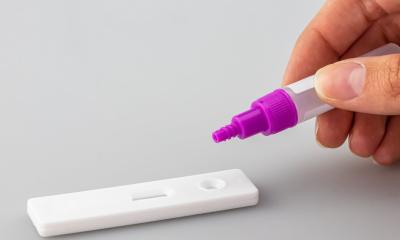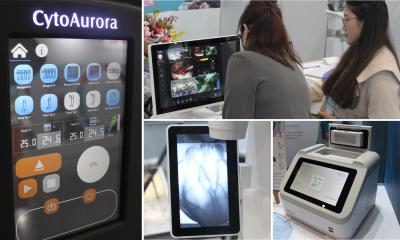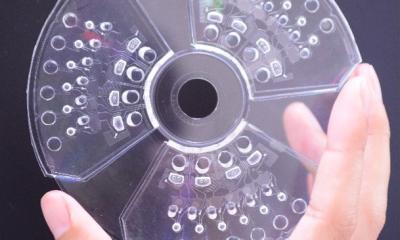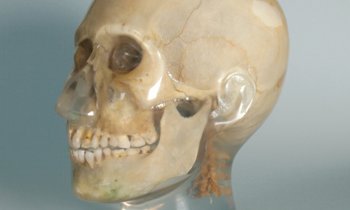© Fraunhofer IPT
News • Pathogen Analyzer
Researchers develop cost-effective PCR test alternative
Speed or accuracy? As far as Covid-19 tests go, this was the choice you had to make. In the future, this dilemma could be a thing of the past. The Pathogen Analyzer combines the advantages of PCR testing and rapid antigen testing – it provides a reliable result after only 20 to 40 minutes. In not too long, this assay will be able to simultaneously detect up to 11 other pathogens.
A demonstrator of the system will be exhibited at the Medica trade fair in Düsseldorf from November 14 to 17, 2022 (Hall 3, Booth E74/F74).
You have a sore throat and you feel exhausted. Have you caught Covid-19? You can find out quickly at home or at a testing site using a rapid antigen test – but the accuracy of these tests leaves a lot to be desired. Protein-based tests, where viral antigens are recognized on the chip, are simply not as accurate as nucleic acid-based tests. In other words: Many infections go undetected and false positive results are also possible. You need a PCR test to get a reliable result; however, this is both significantly more expensive and more time consuming – it can take up to two days for the result to be available.
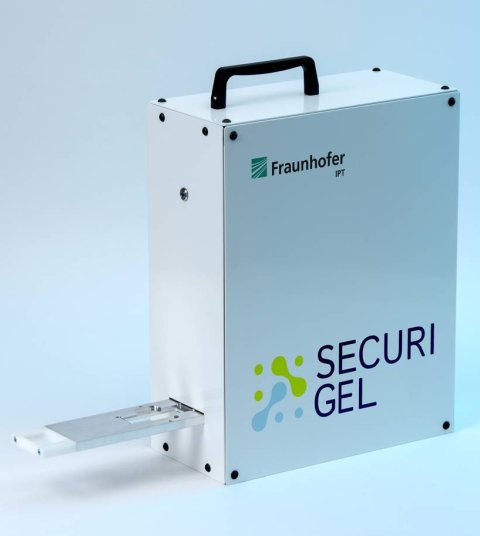
© Fraunhofer IPT
A group of researchers from the Fraunhofer Institute for Production Technology IPT, the Fraunhofer Institute for Interfacial Engineering and Biotechnology IGB and the Fraunhofer Center for Manufacturing Innovation in Boston (USA) now wants to change that. “With our Pathogen Analyzer, we combine the advantages of antigen and PCR testing. As we detect the genetic material of the viruses directly, as in a PCR test, the results are extremely accurate. However, we use a different method to duplicate the genetic material, which means that the result is available after just 20 to 40 minutes,” says Daniel Reibert, a scientist at Fraunhofer IPT. To do this, the researchers printed multiple small hydrogel droplets onto a test chip, which is similar in size to a rapid antigen test; experts call these droplets 'biosensors'. The sample – which, as with previous tests, is obtained via a nasopharyngeal swab and transferred to a buffer solution – is applied to this chip. The test chip is then heated to 62 degrees Celsius in a compact and mobile analyzer. The buffer solution and the high temperature expose the genetic material of the virus and multiply the nucleic acids for quantitative detection within the biosensors. This reaction takes place at a constant temperature – the heating and cooling of the sample liquid that is biochemically necessary for a PCR test is not required. To receive their personalized test results, patients can connect a smartphone app to the analyzer. A light signal in the analyzer detects the amount of the pathogen’s genetic material and sends the final result directly to the affected person.
As we developed the system to be modular, it can be quickly adapted to test for new pathogens
Daniel Reibert
Another innovation: “Each biosensor contains capture molecules that emit fluorescent radiation of a different wavelength when irradiated with light if they have captured the appropriate pathogen. As such, each biosensor is like a small individual test,” explains Reibert. Taking a multiplexing approach not only increases the reliability of the results but also makes it possible to detect up to 12 different types of viruses simultaneously using a single sample and a single test chip. “As we developed the system to be modular, it can be quickly adapted to test for new pathogens,” says Reibert.
One of the challenges was to help develop the subsequent manufacturing processes for the test and ensure that they were inexpensive – after all, the test should not cost more than one euro when mass-produced. For the chip itself, the researchers are therefore relying on roll-to-roll processing. The individual sample biosensors can be printed using either a 3D printer or the established screen printing process.
Recommended article

Article • Detecting several different diseases
Multiplex diagnostics: next-generation techniques for new challenges
With the rise of syndrome-style infections, co-infections and the current antimicrobial resistance challenges, the need for multiplexed diagnostics is now more important than ever.
At the Medica trade fair in Düsseldorf from November 14 to 17, 2022, the researchers will present both a demonstrator of the chip for three pathogens and an analyzer demonstrator (Hall 3, Booth E74/F74). In the long term, the test should also function without an analyzer, being fully usable with just a smartphone: Cellphones already come equipped with a light source and camera, and the heating element can be integrated into the test chip itself. Then, the researchers hope, the test could provide fast, inexpensive and reliable results not only in central locations such as stadiums or doctors’ offices but also directly at home – and for a wide range of pathogens.
Source: Fraunhofer Institute for Production Technology IPT
05.11.2022



